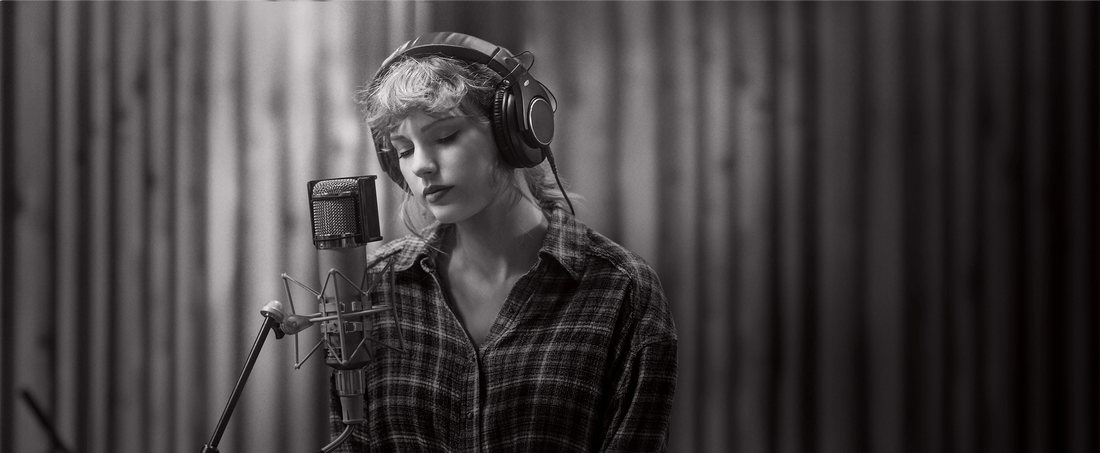If Andy Warhol were alive today, he’d be rolling out his celebrity silkscreens of Taylor Swift, in Life Saver candy colors like those of Marilyn Monroe, Elizabeth Taylor, and Elvis Presley.
The difference is that while celebrity stalks Swift, she stalks right back. She is, at her best, a songwriter first, the most celebrated yet elusive singer-songwriter of her era. The gossip press lavishes attention on past relationships with musicians Joe Jonas and John Mayer; the business pages cover her battles with former manager Scooter Braun over ownership of master tapes and music publishing. And Kanye West grabbing the mic from her, rudely interrupting her acceptance of a prize at the 2009 Video Music Awards? In Constance Grady’s wonderful 2019 Vox story noting the 10th anniversary of the monumental moment, it may have been the event that superpowered the arrival of a relatively new platform called Twitter.
All these years later, their rivalry is still being parsed for references in each other’s music, while the event is part of American folklore. Which is the name of one of two albums Swift released in 2020, the making of which is the subject of Folklore: The Long Pond Studio Sessions, a Disney+ full-length documentary.
 Taylor Swift. Image courtesy of TAS Rights Management.
Taylor Swift. Image courtesy of TAS Rights Management.
The video film, directed and produced by Swift, offers a straightforward breakdown of each track on the album in sequence, followed by spare but effective performances by the principals: Swift, her longtime producer Jack Antonoff, and musician Aaron Dessner from the rock band The National. (Engineer Laura Sisk peeks out briefly from another room.) It lacks the tasteful overdubs and mild orchestrations of the already sparsely arranged studio album. But these versions are all the better for it. The ease and comfort with which the three of them hang out and chat is especially appealing. While the talk is almost entirely about the making of the songs and music, it allows Swift to speak of personal things that you might not get otherwise.
Swift wrote most of the songs with either Antonoff or Dessner during COVID-19 quarantine, although the film reveals the emergence of a Swift collaborator originally listed with the pseudonym “William Bowery.” On those three songs – “Betty,” “August,” and “Cardigan” – co-author Bowery is actually Joe Alwyn, a British actor and Swift’s boyfriend. It’s a relationship that appears to be steady, more long-lasting and with less drama than those previously revealed in the gossip media. These three songs were described in a LiveChat by Swift as a “teenage love triangle” trilogy. Perhaps the stability of her relationship with Alwyn has allowed her to look back with the perspective she lacked as a show biz kid.
Stars of Swift’s magnitude don’t often play well with others. But the ability to collaborate in songwriting has been part of the consistent quality and unpredictable variety of her music from the beginning.
Swift was an immediate star at 16 in 2006 with her debut album, Taylor Swift, an almost perfect country album with many of the songs co-written with Nashville songwriter Liz Rose. Swift was too smart and ambitious for country to contain her, but she was still a fine collaborator. To be clear, Swift remained in charge of her own shapeshifting. The break with country music was consummated with a three-album run with Swedish pop-dance hitmaker Max Martin on Red (2012), 1989 (2014), and Reputation (2017), on which Martin leaves only faint fingerprints. They are Swift’s albums.
She moved towards alternative rock with “Cruel Summer” from her rhythmic 2019 album Lover, written with Antonoff and Annie Clark, who records as St. Vincent, and Reputation even flirted with electronic dance music, a move that won some fans and left others behind. On folklore, recorded in quarantine, there is a long distance collaboration between Swift and Bon Iver (aka Justin Vernon), the bard of Eau Claire, WI, intense and uncompromising.

The boldest attempt to reframe Swift’s fluid styles, and to recognize her power as a songwriter, was her album 1989. Named after the year she was born, the 2014 Grammy Album of the Year was covered in its entirety by indie rock star Ryan Adams. It wasn’t a joke, or a diss: it was a standalone success, an indication of how adaptable Swift’s music could be. Swift’s co-writers on the album included Antonoff, Martin, and Ryan Tedder of OneRepublic. In an interview with USA Today in 2015, Adams told reporter Brian Mansfield that Swift had called him a few years earlier to collaborate on a song while she was finishing Red. The tune was never released, but Swift had told him that he had influenced her songwriting. The kinship, Adams joked, was “we’re the F to A minor club.” In other words, it’s not about fame or personality; it’s about sharing similar approaches to the work.
He heard in Swift’s songs what she expresses so well in the film, in the small talk she shares with Antonoff and Dessner as they explore tweaks in melody, the accidental chord changes, the intuitive sense that well, this little touch might be a little better than that. (The New York Times did a fine 10-minute interview video on the making of the song “Lover” that is an outstanding peek into Swift’s seriousness of purpose and artisanal dedication to craft.)
“There’s that special, very interesting ingredient where you hear a skeleton of the song, just the bones, and her voice, and you go, ‘Well, of course, this person plays to 60,000 people.’,” Adams said. Later, on Twitter, he said of Swift: “every tune of hers is like the one you wait a whole lifetime to write.”
Almost every song on folklore has a lyric line or rhyme that makes you stop and pay attention, because it advances the story with the unexpected effect of its flavor. At the end of the first verse of the first song, “the 1,” Swift is remembering an old relationship, and sings, “I hit the Sunday matinée/You know the greatest films of all time were never made.” Where does that come from? A Sunday matinée is a notion from the era before multiplex theaters and big screen TVs, perhaps even before affordable air conditioning, when loners or couples or families would go to an afternoon movie no matter what was playing to get out of the summer heat, the one community shelter where it was cold: the downtown movie theater.
In “cardigan,” already one of her signature tunes (she displays a wardrobe full of the namesake sweaters in a Capital One TV ad), she follows a romance from teen days to more adult times in New York…mentions of downtown bars, the fine alliteration of “your heartbeat on the High Line.” But later in the song, there’s a line that looks back again: “Chasin’ shadows in the grocery line.” The image just appears, enlivening the song, evoking a past lover, or perhaps the sense that she feels she’s known her current lover forever.
There are songs about madness here, both in terms of anger and insanity. The angry song, “Mad Woman,” seems to be a poison arrow to former manager Scooter Braun. “Every time you call me crazy, I get more crazy, what about that?” she sings, with the pride and defiance that Tom Petty brought to “I Won’t Back Down,” also likely about a confrontation with what he considered a greedy record label.
Perhaps my favorite song is “The Last American Dynasty,” which tells the story of the heiress Rebekah Harkness, a brilliant, artistic, troubled woman. The song is about the scandals Harkness caused in old money Rhode Island after her wealthy husband died seven years into the marriage, at their manse in ultra-posh Watch Hill, an estate named Holiday House. She scandalized the neighbors, building a dome for the Joffrey Ballet Company, (and later the Harkness Ballet Company) on which Rebekah spent much of her fortune.
Ostensibly about this madwoman obsessed with the desire to be an artist herself, there are elements of both autobiography and invention. In the song, the locals sneered at the widow of Bill Harkness, an heir to the Standard Oil fortune: Swift imagines the condescending neighbors thinking she partied him to death. “And the town said, ‘how did a middle class divorcée do it’?”
This is not exactly true: Rebekah was not middle class in any way. She was also ruling class rich, from one of the wealthiest families in St. Louis. Her father was co-founder of the investment bank G.H. Walker & Co., the company name belonging to George Herbert Walker, the grandfather and great-grandfather of the two Presidents Bush. According to the New England Historical Society, Rebekah’s St. Louis family also had a summer house in Watch Hill, among blue blood royalty, and some Hollywood interlopers like Clark Gable and Douglas Fairbanks.
But the song resonates powerfully, because Taylor Swift bought Holiday House, this immense mansion and beachfront land, for $17 million in cash in 2013 when she was 23 years old. And she has had her own noisy parties there. The most vivid line in the song is in the chorus: “There goes the maddest woman this town has ever seen/She had a marvelous time ruining everything.”
In the movie, Swift says the song is not about herself. And Harkness’ life and that of her family was filled with tragedy, drug and alcohol abuse, and mental illness. It’s not a life to envy. And yet there’s a part of Taylor Swift, a driver of her songwriting genius, that kind of loves the idea that “she had a marvelous time ruining everything” would make a fascinating epitaph, or at least a mission statement for this phase of her bounteous career.



